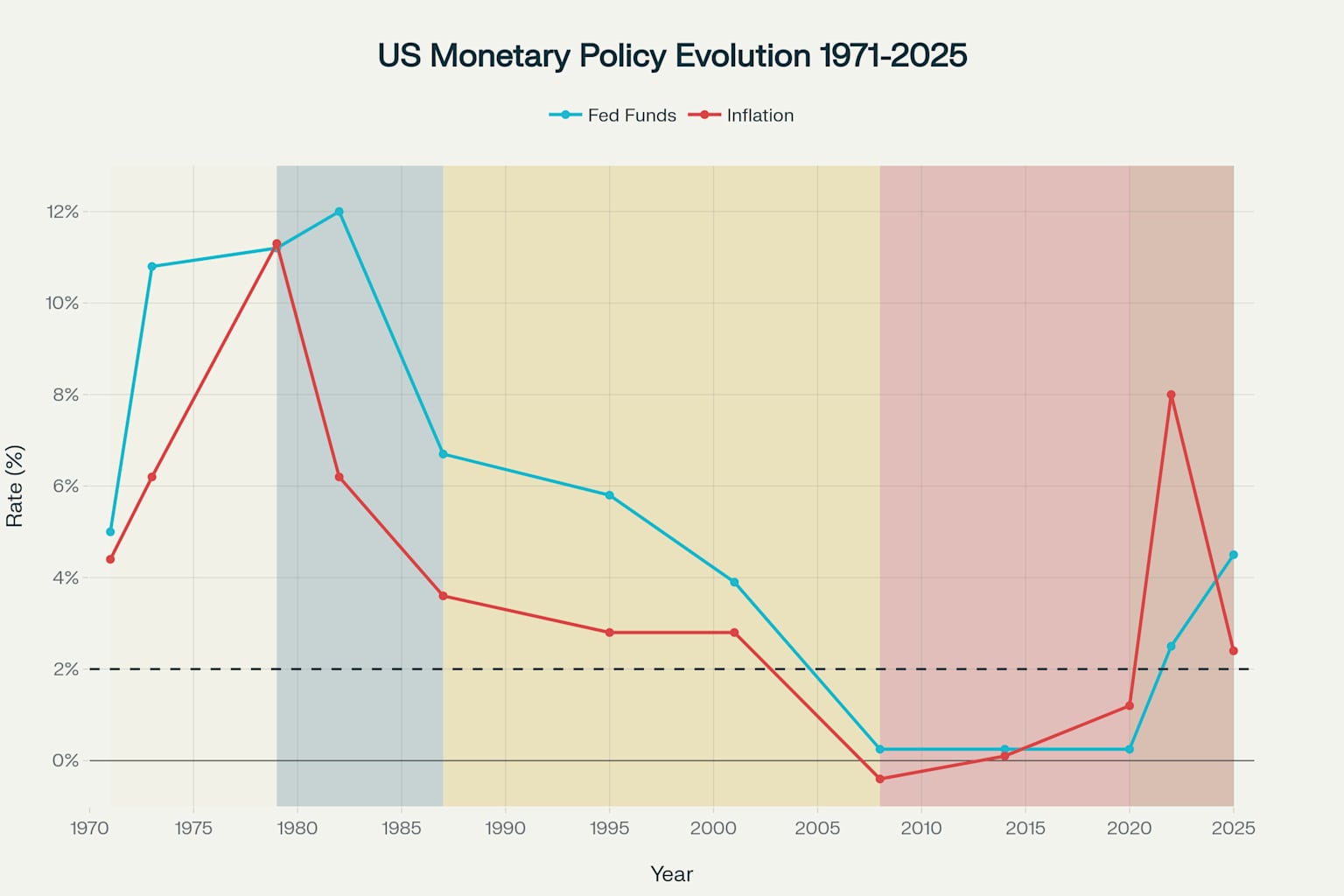Evolution of US Monetary Policy
From the Nixon Shock to Present (1971-2025)
A comprehensive journey through five decades of Federal Reserve policy, key inflection points, and the evolution of central banking in the United States.
Historical Context: The Bretton Woods Era
Pre-1971: The Gold Standard System
- Fixed Exchange Rates: Currencies pegged to the US dollar
- Gold Convertibility: $35 per ounce fixed rate
- Limited Monetary Policy: Constrained by gold reserves
- International Stability: But growing structural imbalances
Growing Pressures by 1971:
Vietnam War spending creating fiscal deficits
Rising inflation undermining dollar confidence
International run on US gold reserves
Trade deficits weakening US position
The Nixon Shock (1971)
The Foundation of Modern Monetary Policy
Fed Chair: Arthur Burns (1970-1978)
"Accommodative policy during stagflation"
August 15, 1971: Historic Announcement
- End of gold convertibility ($35/ounce fixed rate)
- Wage and price controls implemented
- 10% import surcharge imposed
- Birth of the modern fiat money system
Impact & Significance:
Bretton Woods collapse marked the beginning of the fiat money era, giving the Federal Reserve unprecedented flexibility in monetary policy but also new challenges in maintaining price stability.
The Stagflation Crisis (1973-1979)
When Traditional Economics Failed
Perfect Storm of Factors:
- Oil Shocks: 1973 & 1979 oil crises
- Supply Disruptions: Food and energy price spikes
- Wage-Price Spiral: Expectations driving inflation
- Policy Confusion: Fed torn between goals
Keynesian Economics Challenged:
The Phillips Curve relationship between unemployment and inflation broke down. High inflation coexisted with high unemployment, something traditional economic theory said was impossible.
Key Lessons:
Demonstrated the limits of traditional monetary policy and the critical importance of inflation expectations management.
The Volcker Era (1979-1987)
Breaking the Back of Inflation
Fed Chair: Paul Volcker (1979-1987)
"Dramatic interest rate increases, monetarist approach"
The Volcker Shock (1979-1982):
- Aggressive Rate Hikes: Fed funds rate to 20%+
- Monetarist Focus: Targeting money supply growth
- Credibility First: Price stability over employment
- Political Courage: Withstood enormous pressure
Before (1979)
After (1987)
Legacy & Impact:
Established Fed credibility for price stability. Though it caused severe recessions (1981-82), it permanently changed inflation expectations and laid the groundwork for the Great Moderation.
The Greenspan Era (1987-2006)
The Great Moderation
Fed Chair: Alan Greenspan (1987-2006)
"Implicit inflation targeting, forward guidance, asset bubble response"
Characteristics of the Great Moderation:
Low, Stable Inflation
Consistent 2-3% inflation rates
Steady Growth
Reduced economic volatility
Implicit Targeting
~2% inflation goal (unofficial)
Forward Guidance
Clear communication strategy
Challenges Managed:
- 1987 Black Monday stock crash
- 1990-91 recession and S&L crisis
- Dot-com bubble and bust (2000-2001)
- 9/11 economic impact
Financial Crisis Response (2008)
Birth of Unconventional Monetary Policy
Fed Chair: Ben Bernanke (2006-2014)
"Quantitative easing, zero interest rate policy, forward guidance"
Unprecedented Policy Response:
New Monetary Policy Tools:
Quantitative Easing
Large-scale asset purchases
Forward Guidance
Explicit future policy commitments
Credit Facilities
Direct lending to markets
Balance Sheet Policy
Active portfolio management
Impact:
Prevented a repeat of the Great Depression, but fundamentally expanded the Fed's toolkit and role in financial markets.
Post-Crisis Era (2008-2020)
The New Normal
Ben Bernanke (2006-2014)
Crisis response and QE implementation
Janet Yellen (2014-2018)
Gradual normalization and employment focus
Characteristics of the New Normal:
Lower for Longer
Persistently low interest rates
Gradual Normalization
Slow, telegraphed rate increases
Balance Sheet Legacy
Large Fed balance sheet maintained
Enhanced Communication
Regular press conferences, projections

Recovery Achievements:
- Unemployment fell from 10% to 3.5% (2010-2019)
- Inflation remained below 2% target
- Financial system stability restored
- Gradual rate normalization (2015-2018)
COVID-19 & Recent Developments (2020-2025)
Testing Modern Monetary Policy
Fed Chair: Jerome Powell (2018-present)
"Flexible inflation targeting, COVID-19 response, financial stability focus"
2020 Pandemic Response:
- Emergency Rate Cuts: Fed funds to 0-0.25% (March 2020)
- Unlimited QE: "Whatever it takes" asset purchases
- New Facilities: Municipal bonds, corporate credit
- Coordination: Massive fiscal-monetary cooperation
The Return of Inflation (2021-2022):
Current Policy Framework & Tools
The Modern Fed's Arsenal
Traditional Tools (Pre-2008)
- Federal Funds Rate
- Discount Rate
- Reserve Requirements
- Open Market Operations
Unconventional Tools (Post-2008)
- Quantitative Easing (QE)
- Forward Guidance
- Yield Curve Control
- Balance Sheet Policies
Communication Tools
- FOMC Statements
- Press Conferences
- Economic Projections
- Meeting Minutes
The Fed's Dual Mandate:
Price Stability
2% inflation target (symmetric)
Maximum Employment
Full employment consistent with price stability
Current Status (May 2025):
Key Lessons & Future Outlook
Key Lessons from 54 Years:
1. Credibility is Everything
Volcker's era proved that central bank credibility for price stability is fundamental to effective monetary policy.
2. Flexibility in Tools is Essential
The 2008 crisis showed that unconventional tools become necessary when traditional policy reaches its limits.
3. Communication as Policy Tool
Forward guidance and clear communication have become as important as interest rate changes themselves.
4. Inflation Expectations Matter
Managing inflation expectations is often more important than current inflation levels.
Future Challenges:
🌡️ Climate Finance
Integration of climate risks into monetary policy framework
💱 Digital Currencies
Central Bank Digital Currencies (CBDCs) and crypto regulation
📊 Data Revolution
Big data and AI in monetary policy decision-making
🌍 Global Coordination
Managing spillovers in an interconnected world
Summary: The Evolution Continues
From Nixon Shock to Modern Fed (1971-2025)
The Transformation:
From (1971)
- Gold-constrained policy
- Limited tools
- Unclear objectives
- Poor communication
To (2025)
- Flexible inflation targeting
- Comprehensive toolkit
- Clear dual mandate
- Transparent communication
Looking Ahead:
The Federal Reserve has evolved from a constrained, crisis-reactive institution to a sophisticated, forward-looking central bank. As new challenges emerge—from digital currencies to climate change—the Fed's continued evolution will be critical to maintaining economic stability and prosperity.